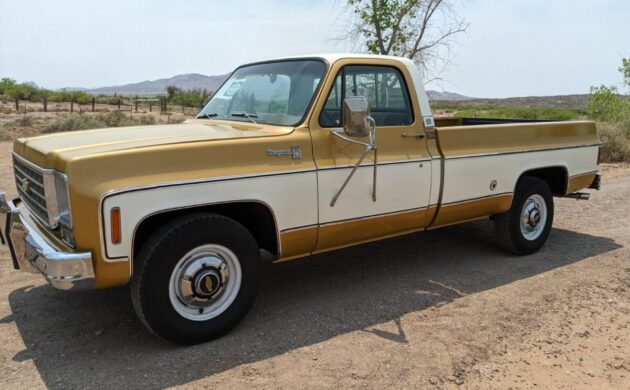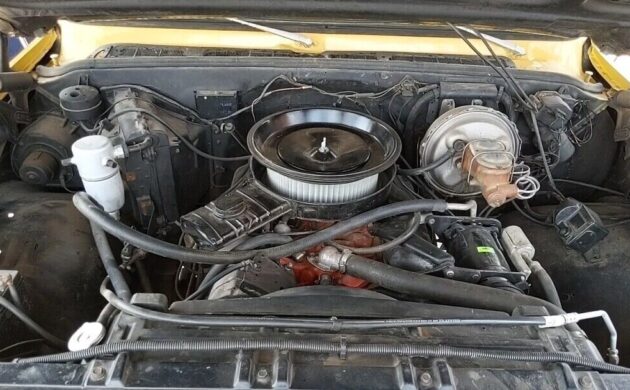GM’s full-size C/K trucks were redesigned in 1973 and the transports would stick around (with changes) through 1987. They were often referred to as the “Square Bodies” because of their boxy shapes. This ’75 edition has both the Cheyenne and Camper Special options along with a big-block 454 cubic inch V8. It comes across as a beautiful survivor that lacks for little, even after 115,000 miles. Located in San Acacia, New Mexico, this looker is ready to be put to work (why?) or hit the local show circuit. It’s available via a dealer here on eBay where the bidding holds at $14,100 and the reserve is still untested.
You don’t see that many of these trucks around anymore, at least in this condition, because they tended to rust from the bottom up. At least here in the Southeast, they did. Back in the 1980s, I recall more of them with partial fenders than complete ones. But with care and a domicile out in the dry Southwest, the seller’s truck is in remarkably sound condition. There are no signs of corrosion, and the two-tone paint shines up nicely. Other than some scratches, even the bed on this long-wheelbase 3/4-ton unit is nice.
When the original owner was checking off boxes on the order form, they marked the box for Cheyenne, which provided a higher level of trim and creature comforts for the truck’s occupants. Said buyer also went for the Camper Special package, which included heavy-duty front and rear shock absorbers, a front heavy-duty stabilizer, camper body wiring, higher-capacity rear springs, and special B-pillar badges. The interior of this pickup looks especially clean and inviting, ready for another 100,000 miles.
Pop the hood and you’ll find the largest of Chevrolet’s V8 engines, the 454 cubic inch motor. Just like with Chevy’s autos, they were detuned for lower emissions and had catalytic converters for the first time. We’re told the truck runs well and the factory air conditioning cools things down nicely thanks to a lot of new parts. The Chevy will sound tough going down the road as the seller has added glass packs to the exhaust system. It will roll down the road quite well, too, with new tires at all four corners.







I had a 1973 C-10 and it was a 2WD, 1/2 ton long wheelbase truck. The “C” (2WD) and “K” (4WD) designation represents the GVWR. A C-10 would be a 1/2 ton, C-20, like this truck, would be a 3/4 ton, and a C-30 would be a 1 ton truck.
You are absolutely correct. 6400 gave classified these trucks as commercial vehicles. I still have the 79 big block Stepside I bought new. It burn unleaded but no cat or smog.
Single exhaust
Till the 1st weekend.
My late father purchased a 1974 GMC equivalent, the 2500, new, back in the day, the GVW of the Camper Special is 8200 lbs, and was badged as such on the B pillar. His had the 454, and he loved matting the go pedal. Sleeper.
There were a few other similar equipped trucks in our rural area, only dealerships were a Chev, Olds dealership, and a Pontiac, Buick, GMC, dealership in the two nearby towns.
A few years later, traded it in for a Chev C20 crew cab, 350 V8, needed more cab room for the family farm business. Way down on the fun factor.
Nice one, Russ! We used to terrorize my small town in one of these that my friend’s parents bought to pull their trailer. HP was down these years but the tire-melting torque and numerically high rear end gears made it formidable compared to the ubiquitous 350-powered cars and trucks of the day. Most cars had to turn a corner to squeal one tire back then, but you could get the Trailering Special going 10 or 15 MPH in a straight line, stand on the pedal, and it would boil both tires. With glass packs that dumped in front of the rear wheels, there was nothing like trolling for victims on a warm evening, windows down. No radio needed when you’ve got the big block symphony. Thanks for the memories!
As always, I’m open to correction… My recollection is that this truck (and any of the 1975 GM trucks above 6000-pound GVW, which would have been 20- and 30-series vehicles) would have continued using leaded regular fuel with no catalytic converter. The 1/2-ton 10-series trucks (like most passenger cars) made the switch to unleaded fuel in 1975. (Dad’s 1978 Chevy K20 pickup with the 5.7-liter/350-V8 still used leaded regular.)
By checking the right option boxes, you could get a C10 or K10 configured so it was just over 6000 lbs GVWR, which put it above the cutoff for less stringent emission controls. This included no catalytic converter and the ability to use leaded fuel. GM marketed this as the “Big 10”. Ford had a similar variant on their F100 and that’s how the F100 morphed into the F150. Around 1980 the EPA got wise to this and changed the rules.
Yes, Bill D., you are absolutely right. I should have pointed out the Big 10 package as a work around to the required catalytic converter on the standard 1/2-ton (F44 Heavy Duty Chassis option, if I remember correctly). Good catch!
one of the ones i wished i kept: 1973 stepside original 454 2wd t400 and i think dana rear that had the option #2 4:11 posi. The int. was buckets with a console and a overhead console also. It had tilt steering and fsctory tach all factory I think it was a rare one,devorice killed it. preety fast truck that i miss
Nice looking pickup I don’t remember what the HP rating was but they were definitely down from previous years. The days before diesel engines in pickups, this would pull hard but do it getting half the mileage of a diesel pickup!